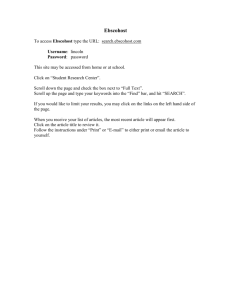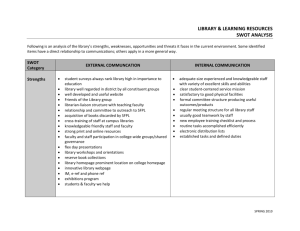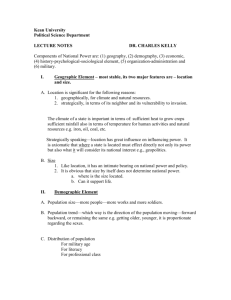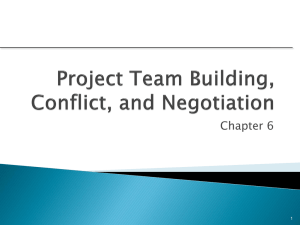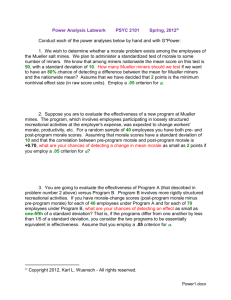research paper - Melissa Kizior
advertisement
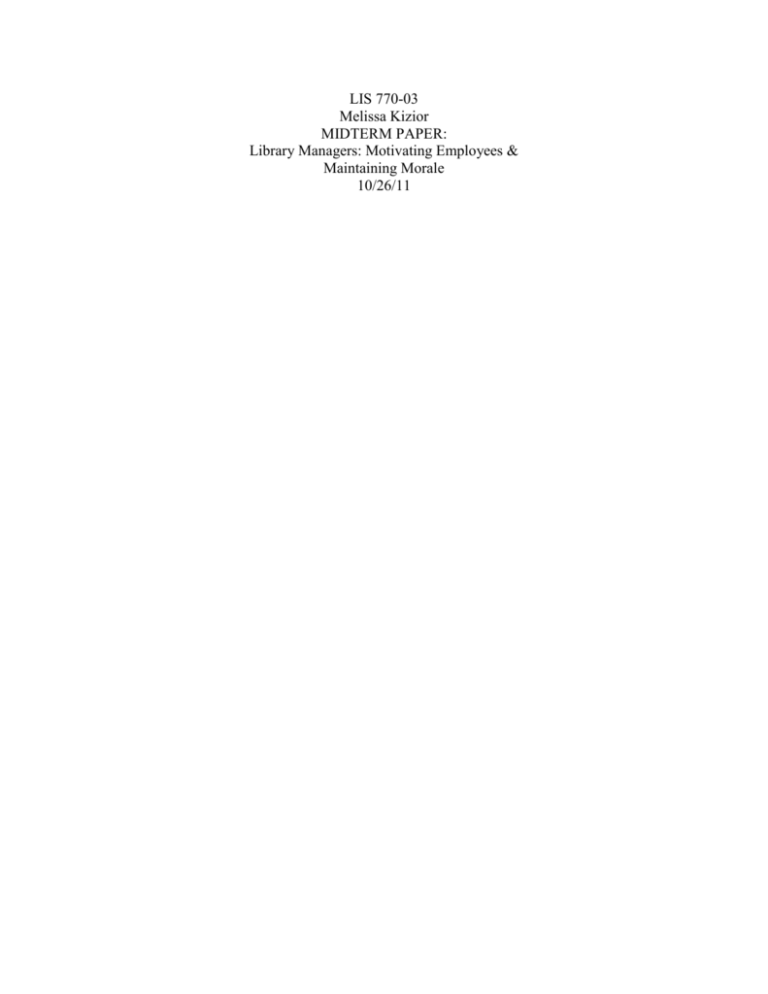
LIS 770-03 Melissa Kizior MIDTERM PAPER: Library Managers: Motivating Employees & Maintaining Morale 10/26/11 The role of library managers in today’s libraries has expanded from that of a mere facilitator or director to one that is infinitely more broad and multi-faceted. Today’s library manager, whether “line” manager, department manager, or director, must be not only a “director” (can be the actual director or a line manager, but still must “direct” staff activities), but also a leader, mentor, “provider of hope” (especially during times of crisis and turmoil), motivator, example (“do as I do”), “active” instead of merely passive, and a team member. As mentioned numerous times in library management and general management literature, library managers must “wear many hats” and he or she must know when, where, and how to wear them to promote the most efficiency in all areas. In order to fully understand why contemporary library managers must live all of the above roles (especially that of motivator), we must first examine several pertinent definitions. The following definitions were found in Merriam-Webster’s 2004 dictionary. A “motive” is described as “something (as a need or desire) that causes a person to act,” while “motivation” means “to provide with a motive.” Motivation can be intrinsic or extrinsic, and it leads to morale (in the library workplace). Finally, “morale” is “the mental and emotional attitudes of an individual to the tasks at hand.” Another definition of morale is “a sense of common purpose with respect to a group” (emphasis added) (Woodruff 2006, 45). Why should library managers be so concerned with the motivations and morale of their employees? One reason is that there are libraries that still exist that are “mired in hierarchical leadership structures, closed communication systems, and restrictive policies [that] drain the life out of users’ curiosity and damage staff morale as well” (Casey and Stephens 2008, 24). In order to best ensure the safety and security of our precious libraries and information centers, we must constantly seek to oust these old and suffocating structures and policies from them. Also, many 1 studies (concerning libraries and other businesses) have shown that higher employee motivation leads to better performance and thus, satisfaction. Then, inevitably, this level of satisfaction is happily passed on to those we intend to serve – the cycle moves outward from staff to patrons to communities. And do we not want a happier, more fulfilling workplace for all (including ourselves)? Further, where would patrons, who are the lifeblood and purpose of our libraries, rather claim as their “third place”? Finally, staff motivation and morale must be important to library managers because high staff morale leads to less employee turnover; thus, the costs and disruptions that are associated with turnover will be lessened as well. Despite the fact that there is not a high level of library employees who are continually coming and going from their positions, library managers should still be concerned with attracting and retaining high-level employees. There are many reasons why employees choose to stay with their companies. Paula Singer and Jeanne Goodrich, authors of “Retaining and Motivating High-Performing Employees,” have found that there are five primary reasons why employees choose to stay (2006, 59). These include that they feel appreciated, that they have made a “difference,” there are growth opportunities available – both within and outside of work, there exists “good” management, and acceptable salaries and benefits. As library managers, we must strive to keep our “high-performing” employees from recruitment through retirement. Their success and motivation should be one of our top priorities. Let us now examine several different “traditional” motivation theories that have been developed over the last century of philosophical thought. Edwin Ellis Badu, in his article, “Employee Motivation in University Libraries in Ghana: A Comparative Analysis,” discusses five important motivational theories (2005, 39). First, Abraham Maslow’s motivation theory holds that there are five types of needs. He proposes a pyramid-shaped diagram with our (all of 2 humanity’s) needs moving from the most “basic” at the bottom (such as physiological, safety, and social) to “higher” needs at the pyramid’s top (self-esteem and then, self-actualization). Maslow maintains that in order for any individual to grow to fulfillment of the higher needs of self-esteem and self-actualization, the basic needs must be met first. Therefore, as library managers we need to concern ourselves with meeting employees’ basic needs such as job security and safety within the workplace (as far as possible in our current economy) before we can assist them with meeting their more advanced and fulfilling needs. The more we can help them to meet their needs, the better motivated and happier they will be. Another theory, by Frederick Herzberg, discusses a “two-factor” theory of motivation – the two factors are “maintenance” and “motivational” (Ugah 2008, 3). Maintenance factors do not build strong motivation; some of these include employees’ salaries, job security, status, and even personal life issues. Motivational factors do build high motivation at work – these are recognition, responsibility, and growth. Therefore, we should strive to secure, increase, and satisfy those factors that lead to higher employee motivation. Victor Vroom developed his “expectancy theory” in 1966. Through it, Vroom talks of positive and negative “rewards.” He purports that more and greater rewards lead to higher motivation. In other words, the more positive rewards that we offer our employees, the higher will be their motivation to succeed at work. Fourth, John Stacey Adams’s motivation theory maintains that rewards should be equal or “fair;” that is, “outcomes” (rewards and results) of employees’ actions should be comparable to their “inputs” (Ugah 2008, 3). Positive “inputs” can be defined as the positive efforts or actions that employees display while at their place of employment. For example, if an employee works successfully on some long-term project and we hardly acknowledge their efforts and subsequent great successes, Adams would not consider this 3 to be a fair reward to match that employee’s actions. Thus, we must recognize and reward our employees fairly for the positive works that they do. Finally, Burrhus Frederic (B.F.) Skinner’s theory of reinforcement claims that positive reinforcement leads to positive behaviors, while negative reinforcement leads to negative behaviors. In the workplace, we should examine how we are reinforcing our employees’ negative or positive behaviors to see what types of motivation and behaviors that we are habitually perpetuating. If any changes are needed, we must move forward with them at once. There are many different approaches that library leaders take in order to better motivate their employees. Michael Casey and Michael Stephens, authors of “Let’s All Lighten Up,” claimed that the tendency is for managers to push their employees harder and “turn up the heat” during difficult times, but studies have shown that is neither productive nor beneficial to either staff or patrons whatsoever (2008, 24). Another approach that is too often attempted to increase morale is that of offering monetary motivations. According to Elisa F. Topper, past director of Dundee Township Public Library District in Illinois, “you may be surprised to learn that monetary rewards do not produce long-term performance and production results anyway. In fact, some research shows that reward programs that only emphasize cash incentives can actually ‘demotivate’ staff by shifting the goal from a sense of accomplishment and contribution to attaining the carrot of the fiscal award” (2004, 96). This is not to say that some economic rewards may not be useful at all; they can be useful in positively motivating staff, as long as they are not the sole objective or purpose of an individual employee’s daily library work. Some “inexpensive morale boosters” include a praise letter, lunch or dinner paid for by the library, an extra paid break, dinner at the manager’s house, plaques, and etcetera (Bruce 1999, 55). 4 Another, quite successful approach to increase motivation and improve morale at work is to increase the “fun quotient” there. According to Adrian Gostick and Scott Christopher, authors of The Levity Effect, “fun at work can provide a competitive advantage, help attract and retain [excellent] employees, and provide the spark to jumpstart creativity” (Casey 2008, 24). Gostick and Christopher also maintain that sometimes it may be necessary to initiate fun activities at work. In their words, “where humor and mirth grow organically, born spontaneously from trusting relationships [at work], these suggestions may be unnecessary. But in our experience, the wheels must be set in motion with some committed attempts at programmed fun” (2008, 151). In chapter seven of their book, they provide us with examples of fun activities at work that we can use to boost library employees’ morale. Some of these are playing games (board, video, card, etc.), themed potlucks, celebrating accomplishments or goals met with food (breakfast, lunch, or dinner), dressing up for Halloween, company-wide sporting events such as bowling or gocarting, holding meetings outside, having a baking contest, and “[creating] a fun committee, and [rotating] membership” (155-161). There are many more (142, to be exact) fun suggestions that they offer in The Levity Effect’s chapter 7 (151-169). Also of importance is that as library managers we must gain our employees’ trust and respect first, be genuine, and if at first we don’t succeed (in applying “fun tactics”) we must try and try again. We should not require participation in any of these planned fun activities, or else they may backfire and thus, defeat our intended purposes. In addition, we should help our employees to set goals that are both clear and attainable, review their goals with them on a regular basis, and do annual or bi-annual assessments of their progress and accomplishments. These goals and assessments can lead to offering employees merit-based pay. That is, their salaries would depend on how they did or did not achieve (and to 5 what degree) the goals and objectives that they set for themselves. Merit-based pay can possibly motivate staff members to stretch themselves to grow in new areas or areas that they themselves have identified as being lacking or needing improvement. It is also important to rotate their duties and projects within the library so that employees may experience first-hand what it is like to truly “walk in each other’s shoes” for a time. This may lead to increased understanding and empathy towards other employees and their daily duties, which may then lead to greater camaraderie and more team-based motivation at work. Library managers must also be flexible when it comes to creating employee work schedules. We need to demonstrate that we truly value (in words and actions) our employees’ personal time spent outside of the working environment. These actions will most definitely increase employees’ intrinsic motivation and cheerful productivity while performing their work duties. We (all staff members) should make a great effort to attend professional events and join organizations/groups, both within and outside of our libraries. The effects here of team-building cannot be underestimated when attempting to further strengthen staff morale. Finally, another approach towards meeting our overall aims is to foster working relationships with all of our staff members. In order to do this, we must be both present and visible. This means that we should be available for our workers when they need us and obviously not “hole” ourselves into our respective offices for much of our time on the clock. We should both “show our faces” and be willing to jump in and assist/fill in for our team members as often as necessary. Giving useful feedback is also important. Our staff must know what we expect of them while at work and feel that we are “on their side” – that is, that we wish more than anything to help them grow and improve (with their accomplishments definitely and duly noted). 6 Several so-called “best” approaches that library managers can take while trying to increase employee motivation and improve morale are plentiful and as follows. They may or may not actually be the best approaches, but I feel that they hold much promise. Library managers should communicate openly and honestly with all staff members. If he or she does not know an answer, then the response to the question(s) must be “I don’t know” and then he or she should make a concerted effort to locate and deliver the answer(s) as quickly as possible. Admitting that we do not have all of the answers is both humbling for us, as well as teambuilding for all staffs. Also, we must offer much recognition and praise (when warranted) – both in public and privately. Don’t be afraid to have a standing ovation from time to time in order to celebrate goals met or outstanding individuals. Creativity must be both harnessed and encouraged. Several ideas to do this in the library are to encourage and hold brainstorming meetings, start (or maintain) a staff blog, and mount a board in a staff hallway with the purpose of capturing employees’ fleeting creative ideas and thoughts (Umbach 2008, 48). All new ideas and suggestions do not need to (and should not) be immediately implemented, but we must give them careful consideration, while remembering that most change is usually frightening and/or uncomfortable at first. These above ideas will encourage staff members to use all of their best ideas and create positive changes together; thus, this will lead to both positive motivation and morale. Don’t forget the importance of celebrating employee birthdays and anniversaries. Simply remembering these special events can go a long way towards intrinsically motivating your employees and helping them to look forward to performing at their best each day. Perhaps the most essential suggestion for us is to “walk the walk” at work, and not just “talk the talk.” If we are not willing to do as we say that others should do, why should anyone else be? Or, they may 7 do as we say, but under only half-steam and/or with brewing anger or resentment. Finally, if you are not sure what your employees would like to have or receive as incentives at work, ask them! Who better to tell you what motivates them than those you aim to encourage? If all else fails, don’t forget to ask. In conclusion, there are nearly infinite methods and ideas that library managers can utilize for increasing staff motivation and morale. Our job is to discover which will fit both our personalities and those that we wish to lead, and then patiently try them out. If one approach doesn’t work, try another. Not all methods are (or can be) useful for all persons, but if we persevere the results are likely to be amazing, even if they occur ever so slowly at first. Positive motivation has a way of being unconsciously contagious; this is definitely something that we want our staff to become intimately afflicted with. Remember to listen to suggestions from all staff members. If managers “allow creative input and suggestions,” … “[then] staff members feel a sense of ownership and pride in where they work. This … fosters a more positive environment which booster’s morale” (Woodruff 2006, 45-46). Then, even the morale of our communities can go up through our positive influence. Library managers need to motivate and keep up the morale of their staffs because public expectations are so rapidly changing as both technology and the world changes. Also, during difficult economic times, “it’s natural for work morale to suffer” (Casey 2008, 24). Thus, it is always our responsibility to help to ensure the satisfaction and happiness of our employees (and consequently, ours as well). As the “flattening” of the management structure of organizations increases in many areas of the world, we are becoming much more team-oriented than ever before. What we do or do not do to our fellow workers, we also do to ourselves as well. As library teams, we must work together or perish. That includes each and every staff member, 8 manager or not. And finally, if all of the above suggestions and information has not convinced you of the true importance of employee motivation and morale in today’s libraries, simply ask yourself, “What type of library environment would I like to work in and perpetuate?” 9 Bibliography Badu, Edwin Ellis. 2005. "Employee Motivation in University Libraries in Ghana: a comparative analysis." Information Development 21, no. 1: 38-46. Library, Information Science & Technology Abstracts with Full Text, EBSCOhost (accessed September 21, 2011). Bruce, Anne, and James S. Pepitone. 1999. Motivating Employees. New York: McGraw Hill. Casey, Michael, and Michael Stephens. 2008. "Let's All Lighten Up." Library Journal 133, no. 13: 24. Library, Information Science & Technology Abstracts with Full Text, EBSCOhost (accessed September 21, 2011). Coffee, Carol. 2009. "Encouraging Your Staff to Learn." Arkansas Libraries 66, no. 2: 11-12. Library, Information Science & Technology Abstracts with Full Text, EBSCOhost (accessed September 21, 2011). Dziedzic, Donna. 2011. "Staffing in Times of Crisis." ILA Reporter 29, no. 2: 4-6. Library, Information Science & Technology Abstracts with Full Text, EBSCOhost (accessed September 21, 2011). Gostick, Adrian Robert, and Scott Christopher. 2008. The Levity Effect: Why It Pays to Lighten Up. Hoboken, N.J.: John Wiley & Sons. Hsiu-Fen, Lin. 2007. "Effects of extrinsic and intrinsic motivation on employee knowledge sharing intentions." Journal of Information Science 33, no. 2: 135-149. Library, Information Science & Technology Abstracts with Full Text, EBSCOhost (accessed September 21, 2011). Leonard, Elisabeth, Hollie White, and Tonia Graves. 2009. "Managing with Integrity." Serials Librarian 56, no. 1-4: 25-31. Library, Information Science & Technology Abstracts with Full Text, EBSCOhost (accessed October 10, 2011). Manley, Will. 2008. "Is Everybody Happy?." American Libraries, March. 88. Library, Information Science & Technology Abstracts with Full Text, EBSCOhost (accessed October 10, 2011). Merriam-Webster, Inc. 2004. The Merriam-Webster Dictionary. Springfield, Mass: MerriamWebster. Singer, Paula, and Jeanne Goodrich. 2006. "Retaining and Motivating High-Performing Employees." Public Libraries 45, no. 1: 58-63. Library, Information Science & Technology Abstracts with Full Text, EBSCOhost (accessed September 21, 2011). 10 Topper, Elisa F. 2004. "Working Knowledge." American Libraries 35, no. 1: 96. Library, Information Science & Technology Abstracts with Full Text, EBSCOhost (accessed October 10, 2011). Ugah, Akobundu Dike. 2008. "Motivation and Productivity in the Library." Library Philosophy & Practice 10, no. 2: 1-6. Library, Information Science & Technology Abstracts with Full Text, EBSCOhost (accessed September 21, 2011). Umbach, Judith M. 2008. "Nurturing Creativity." Feliciter, April. 48. Library, Information Science & Technology Abstracts with Full Text, EBSCOhost (accessed October 10, 2011). Woodruff, Sarah. 2006. "Rah! Rah! Go, Staff Morale! : What We Can Learn From Flying Fish & Contented Cows." Indiana Libraries 25, no. 3: 45-47. Library, Information Science & Technology Abstracts with Full Text, EBSCOhost (accessed October 10, 2011). 11

